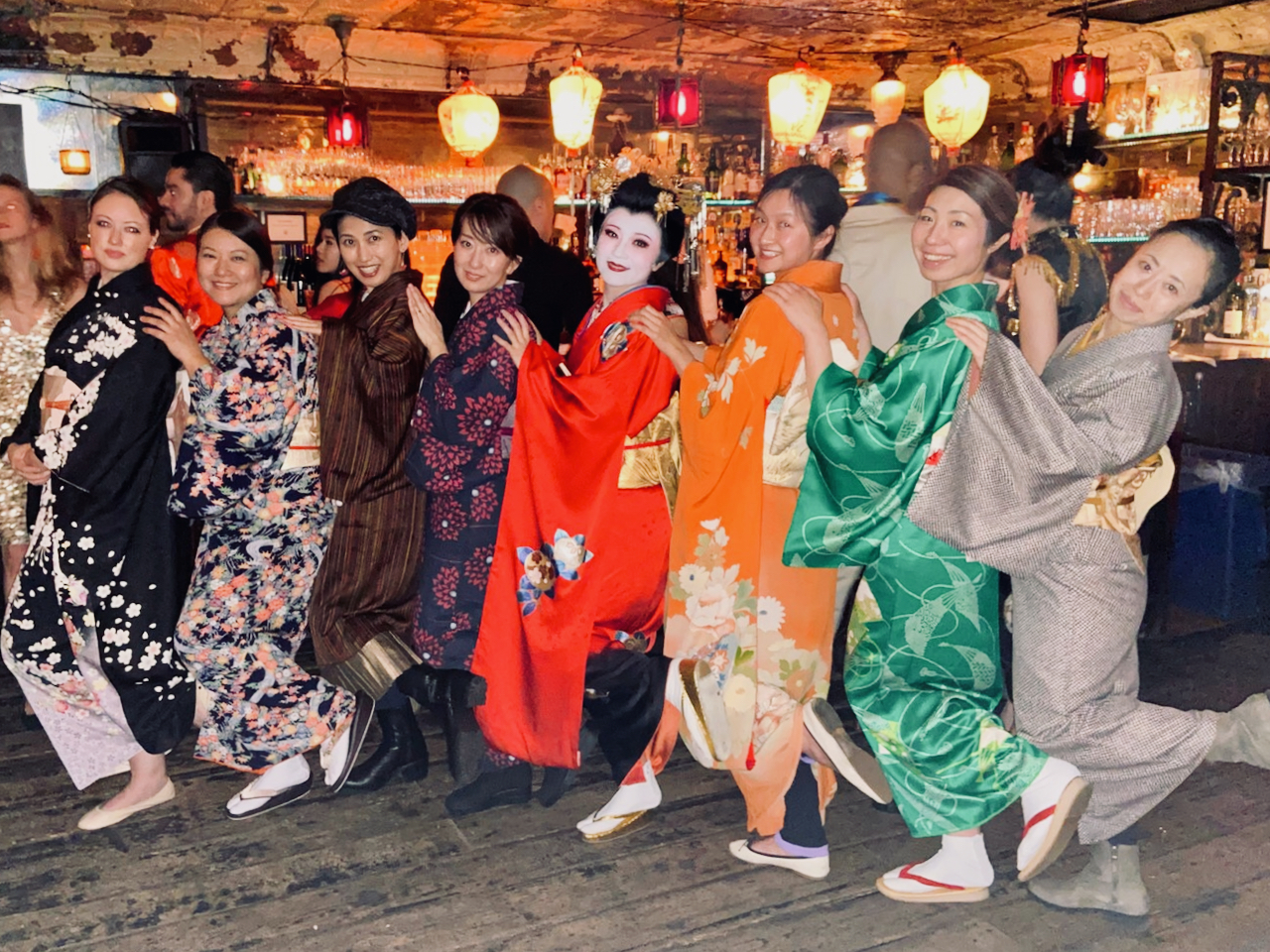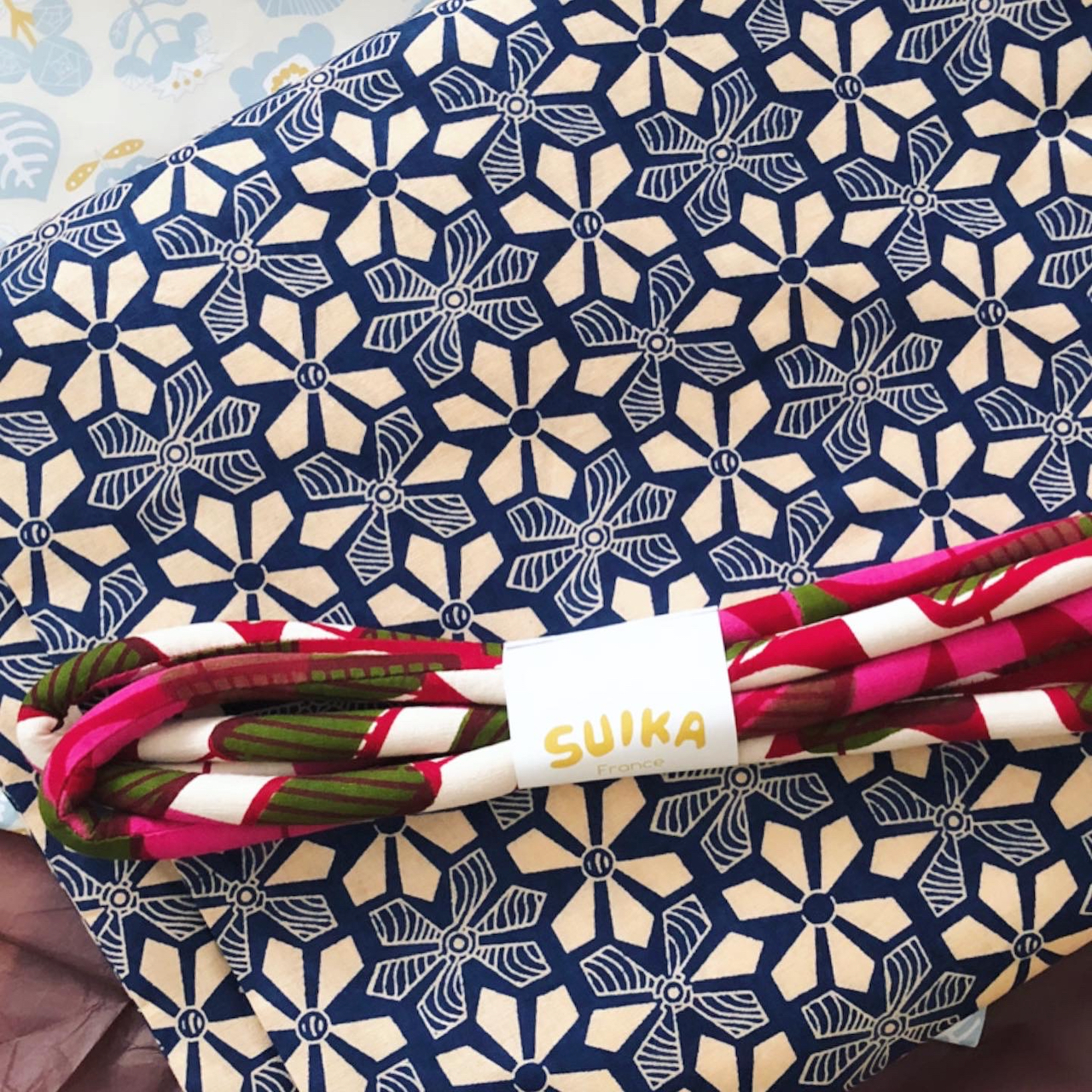Since moving to New York, where so many people comes from all over the world, I have come to be intensely conscious of my own cultural roots and those of others. A friend of mine from India always hosts her parties dressed in a beautiful sari. A Muslimah that I met through at work is a social media influencer who introduces hijabs with decorative roll up style of arrangement. Unique Cultures cannot be completely mixed with other cultures even though living in the same town, speaking the same language, but that situation is really beautiful. I guess it was the atmosphere of this town that led me to consider of wearing kimonos even though I had been keeping them at a distance.
Japanese vintage spreads around the world
From last autumn, I started taking lessons at a kimono-wearing class in the East Village located near my house. We use an instruction manual based on the Yamano-Ryu style of kimono-wearing and written in both Japanese and English. The classmates are not only Japanese and American students, but also Italians, Taiwanese, France and other nationalities. We studied in a very small group 1 day a week in the meeting room of a co-working space. I finally completed the first level of study. Due to the influence of COVID-19 the classes have been closed, but I would like to resume my studies when possible.
When I talk about this, they say with worry at first, ‘doesn’t it cost a lot of money?!’. That is probably because many people have image of kimonos as extremely gorgeous garments. An example of this would be like the kimono that Matsu Takako wore to this year’s ‘92nd Academy Awards show’. It was so lovely that makes one dizzy, however, if I were to put it in terms of European clothes, it would be something like haute couture dress. In my case, most of items I own are causal kimono types that one can wear on a daily basis like jeans or cut and sew. And moreover, most of these were second hand items.
The scale of the kimono market is shrinking tangibly and one surveys report that less than 10% of the female population in Japan wear a kimono more than a few times a year. Because of this, you can get a real treasure of an owner-less kimono for just a few thousand yen. Personally, I have bought a Nagoya Obi for 10 dollars from a woman in Virginia and I imported 3 kimonos for 9,000 yen that were on sale from foreign shop owner living in Japan.
Actually, I could say that I am quite crazy about shopping at ‘low priced thrifted clothes sites’, rather than about kimono traditions itself.
While an initial investment is required, if you get 1 full set of dressing accessories, you will be able to deck yours with antique items made before your grandmother was born. For the same price as you would pay for a blouse or dress that has quickly been abandoned due to changes in fashion trends, you can be the owner of a durable, high quality, magical garment of clothing: a kimono that you can wear all your life.
Kimonos have their own sort of feeling of freedom
However, some people launch into kimonos with comments like, ‘but, don’t kimonos restrict movement, right?’. They might experience very tough situations wearing one at Japanese ceremonies like ‘Shichi-Go-San’, coming of age, or wedding ceremonies. There are also feminists who show their resistance to kimonos with comments like, ‘the way kimonos bind up the body is so tight that they restrict a woman’s movements. Kimono don’t differ from other relics from the past that steal women’s freedom just like corsets or foot binding’. And so was I, too.
However, have their own sort of unique kimono feeling of freedom. While it is true that it takes a great deal of time and effort to actually wear, and it would be a lie to say that there are not a lot of detailed and strict rules; if you practice enough tightening your Obi doesn’t really cause any hardship. At least I can proclaim that a kimono does not scar my pride as much as trying to once again zip up the fastener on a mini skirt that I bought way back when. When one is selecting clothes with it larger amount of body exposure one is faced with a sorts of negative constraints such as, ‘my stocky legs won’t look good in this’, ‘my hips are too big for this’, ‘I don’t look as good in this when I was young’, and other such thoughts. On the other hand, in the world of kimono, the garments supply a thorough supporting framework for one’s body making it possible to wear clothes in any way that one desires.
Last winter, the students of our kimono-wearing class lined up voluntarily for a group photograph. Then, I couldn’t help being surprised by the sense of unity of dressed up women much like ‘Sailor Moon’ ’s transformation. I mean, we are all so vastly different in every aspect from our nationalities, ages, body types and everything else. There were tall, full bodied Caucasians, short, petite Asians, muscular dancers as well as slightly plump mothers with children of their own. Prior to this transformation in our European clothes, we seemed bumpy and jagged without any features in common.
However, by adorning ourselves in this Japanese way of dress, we all came together in one single, unified and traditional golden ratio of harmony. Full breasted women became less so, women with body parts that were too thin looked more bountiful with towel wrapping enhancement. The length and size of one’s collar and sleeves are adjusted to suit one’s height and length of arms and legs. This process reminds of my design work process, what I first enter my hand drawn rough sketch into the drafting software’s grid and then go on to create fair copy.
Because of the fact that everyone dresses in accordance with a single, unified standard, each person’s unique taste they add to their decorations and coordinates actually stand out all the more. Wrapping up and hiding much of the body does not means covering up our own individuality. It gives one the feeling of being firmly wrapped with safety assuring, calming cushioning and then being beautifully decorated in lovely gift wrapping. All these diversified students are at the same time both ‘the same’ and yet ‘different’. This template fashion that made me feel free from complex of my body shape.
To whom Japanese culture belong?
This is not all simply about the body. Japanese kimonos adopt all different types of cloth from all over the world. They make use of everything from Sarasa textile from India and Java, Swatow embroidery from China, western forms of lace cloth, stained glass images and designs depicted on Egyptian wall murals and so. A new garment that I bought recently was a summer Yukata made of African fabric. The pattern that perfectly reproduces a snow flower design provides the eyes with coolness, and from a distance, the pattern looks just like a traditional Japanese one.
And much surprisingly, Kimono suits non-Japanese, too. If I want to wear pale colored kimono, I would be always suggested to change the skin tone by traditional make-up. So I am always blown away when the same kimono fits ladies in other skin colors very well in a natural way. It looks like tailored clothes which had waited to be worn by them for tens of years. There are so many motivations lying behind the reason the varied students decided to attend the kimono-wearing class. Some started because of an admiration for a certain Japanese writer or athlete while others love manga or anime. I’m pretty sure people, from Whom I bought antique kimono and dealt in English, are of this type of kimono lovers.
In 2019 when Kim Kardashian took out the registered trademark name of, ‘Kimono’ for her company product line, it was the Asian community in America that rallied against it from the very outset followed by kimono lovers living outside of Japan. I had the impression that the issuance of an opinion on this matter from the Japanese apparel industry came one step behind foreign counterparts. Japanese culture, like the kimono, is now no longer simply a Japanese thing.
With restrictions of travel and quarantine for now and the near future, COVID-19 era, will make it very difficult to ‘physically travel the world. Furthermore, it will become ever more undoubtedly difficult to turn one’s attention to what is happen ‘outside’ of one’s home country. In spite of that, various forms of fashion spanning from the cool and cute to repulsive things that one doesn’t want to accept will continue to spread throughout the world in a flash. Even if the borders of a country are sealed off from the rest of the world, the range of culture will go on to expand unhindered. We who inhabit this world of multicultural co-existence may perhaps find it necessary to repeatedly inquire of ourselves about how we deal with our own roots.
Picture Provided Iku Okada
Translation Konan Translation Service



